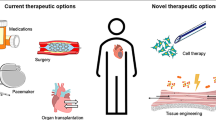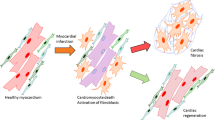Abstract
Introduction
The electrophysiological consequences of mesenchymal stem cell (MSC) therapy in ischemic heart disease have not been fully understood.
Methods
Swine myocardial infarction (MI) model by intracoronary balloon occlusion received MSC solution or 0.9% NaCl. Six weeks later, heart rate turbulence (HRT), dispersion of action potential durations (APD) and repolarization time (RT) (APDd and RTd), slope of APD reconstitution curve and programmed electrical stimulation were used to evaluate the ventricular arrhythmic risks.
Results
MSC treatment could significantly ameliorate the abnormal HRT, APD90, APDd, RT and RTd. The slope of APD reconstitution curve in MSC group was higher than control group but lower than MI group. MSC therapy markedly reduced inducible malignant ventricular arrhythmias (VAs), and improved impaired cardiac performances and cardiac fibrosis.
Conclusions
This study provides strong evidence that MSC infusion via intracoronary route does not cause VAs but tends to reduce the risk of malignant VAs.



Similar content being viewed by others
References
Janssens S, Dubois C, Bogaert J et al (2006) Autologous bone marrow-derived stem-cell transfer in patients with ST-segment elevation myocardial infarction: double-blind, randomised controlled trial. Lancet 367:113–121
Perin EC, Dohmann HF, Borojevic R et al (2003) Transendocardial, autologous bone marrow cell transplantation for severe, chronic ischemic heart failure. Circulation 107:2294–2302
Menasche P, Hagege AA, Vilquin JT et al (2003) Autologous skeletal myoblast transplantation for severe postinfarction left ventricular dysfunction. J Am Coll Cardiol 41:1078–1083
Chen HS, Kim C, Mercola M (2009) Electrophysiological challenges of cell-based myocardial repair. Circulation 120:2496–2508
Roell W, Lewalter T, Sasse P et al (2007) Engraftment of connexin 43-expressing cells prevents post-infarct arrhythmia. Nature 450:819–824
Beeres SL, Zeppenfeld K, Bax JJ et al (2007) Electrophysiological and arrhythmogenic effects of intramyocardial bone marrow cell injection in patients with chronic ischemic heart disease. Heart Rhythm 4:257–265
Hare JM, Traverse JH, Henry TD et al (2009) A randomized, double-blind, placebo-controlled, dose-escalation study of intravenous adult human mesenchymal stem cells (prochymal) after acute myocardial infarction. J Am Coll Cardiol 54:2277–2286
Freyman T, Polin G, Osman H et al (2006) A quantitative, randomized study evaluating three methods of mesenchymal stem cell delivery following myocardial infarction. Eur Heart J 27:1114–1122
Pak HN, Qayyum M, Kim DT et al (2003) Mesenchymal stem cell injection induces cardiac nerve sprouting and increased tenascin expression in a Swine model of myocardial infarction. J Cardiovasc Electrophysiol 14:841–848
Price MJ, Chou CC, Frantzen M et al (2006) Intravenous mesenchymal stem cell therapy early after reperfused acute myocardial infarction improves left ventricular function and alters electrophysiologic properties. Int J Cardiol 111:231–239
Watanabe MA, Marine JE, Sheldon R et al (2002) Effects of ventricular premature stimulus coupling interval on blood pressure and heart rate turbulence. Circulation 106:325–330
Yuan S, Blomstrom-Lundqvist C, Pripp CM et al (1997) Signed value of monophasic action potential duration difference. A useful measure in evaluation of dispersion of repolarization in patients with ventricular arrhythmias. Eur Heart J 18:1329–1338
Zhao ZQ, Morris CD, Budde JM et al (2003) Inhibition of myocardial apoptosis reduces infarct size and improves regional contractile dysfunction during reperfusion. Cardiovasc Res 59:132–142
Stroud JD, Baicu CF, Barnes MA et al (2002) Viscoelastic properties of pressure overload hypertrophied myocardium: effect of serine protease treatment. Am J Physiol Heart Circ Physiol 282:H2324–H2335
Krause K, Schneider C, Lange C et al (2009) Endocardial electrogram analysis after intramyocardial injection of mesenchymal stem cells in the chronic ischemic myocardium. Pacing Clin Electrophysiol 32:1319–1328
Katritsis DG, Sotiropoulou P, Giazitzoglou E et al (2007) Electrophysiological effects of intracoronary transplantation of autologous mesenchymal and endothelial progenitor cells. Europace 9:167–171
Koller ML, Maier SK, Gelzer AR et al (2005) Altered dynamics of action potential restitution and alternans in humans with structural heart disease. Circulation 112:1542–1548
Ohara T, Ohara K, Cao JM et al (2001) Increased wave break during ventricular fibrillation in the epicardial border zone of hearts with healed myocardial infarction. Circulation 103:1465–1472
Qu Z, Weiss JN, Garfinkel A (1999) Cardiac electrical restitution properties and stability of reentrant spiral waves: a simulation study. Am J Physiol 276:H269–H283
Xie F, Qu Z, Garfinkel A et al (2002) Electrical refractory period restitution and spiral wave reentry in simulated cardiac tissue. Am J Physiol Heart Circ Physiol 283:H448–H460
de Bakker JM, van Capelle FJ, Janse MJ et al (1993) Slow conduction in the infarcted human heart. ‘Zigzag’ course of activation. Circulation 88:915–926
Maeda S, Nishizaki M, Yamawake N et al (2009) Ambulatory ECG-based T-wave alternans and heart rate turbulence predict high risk of arrhythmic events in patients with old myocardial infarction. Circ J 73:2223–2228
Pinto JM, Boyden PA (1999) Electrical remodeling in ischemia and infarction. Cardiovasc Res 42:284–297
Acknowledgments
This work was supported by grants from the National Natural Science of China (30800464, 30871077).
Conflict of interest
No conflict of interest exists in the submission of this manuscript.
Author information
Authors and Affiliations
Corresponding author
Rights and permissions
About this article
Cite this article
Wang, D., Jin, Y., Ding, C. et al. Intracoronary delivery of mesenchymal stem cells reduces proarrhythmogenic risks in swine with myocardial infarction. Ir J Med Sci 180, 379–385 (2011). https://doi.org/10.1007/s11845-011-0687-3
Received:
Accepted:
Published:
Issue Date:
DOI: https://doi.org/10.1007/s11845-011-0687-3




